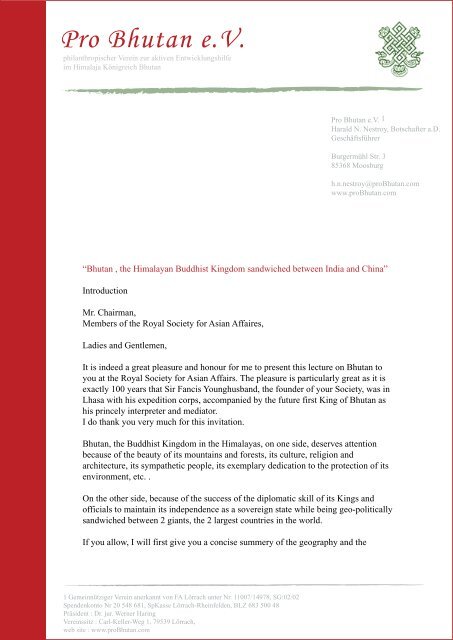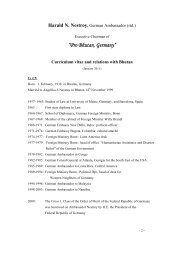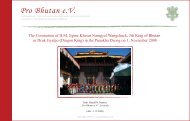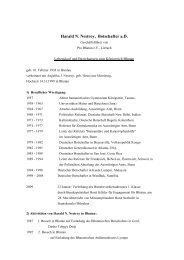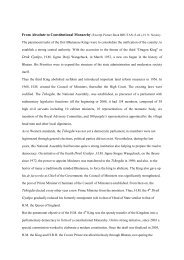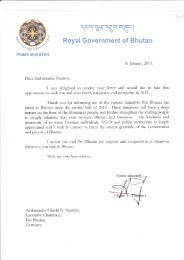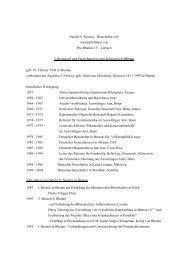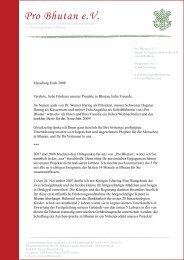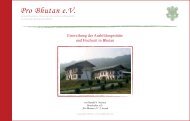“Bhutan , the Himalayan Buddhist Kingdom ... - Pro Bhutan eV
“Bhutan , the Himalayan Buddhist Kingdom ... - Pro Bhutan eV
“Bhutan , the Himalayan Buddhist Kingdom ... - Pro Bhutan eV
Create successful ePaper yourself
Turn your PDF publications into a flip-book with our unique Google optimized e-Paper software.
philanthropischer Verein zur aktiven Entwicklungshilfe<br />
im Himalaja Königreich <strong>Bhutan</strong><br />
1 Gemeinnütziger Verein anerkannt von FA Lörrach unter Nr. 11007/14978, SG:02/02<br />
Spendenkonto Nr 20 548 681, SpKasse Lörrach-Rheinfelden, BLZ 683 500 48<br />
Präsident : Dr. jur. Werner Haring<br />
Vereinssitz : Carl-Keller-Weg 1, 79539 Lörrach,<br />
web site : www.pro<strong>Bhutan</strong>.com<br />
<strong>Pro</strong> <strong>Bhutan</strong> e.V. 1<br />
Harald N. Nestroy, Botschafter a.D.<br />
Geschäftsführer<br />
Burgermühl Str. 3<br />
85368 Moosburg<br />
h.n.nestroy@pro<strong>Bhutan</strong>.com<br />
www.pro<strong>Bhutan</strong>.com<br />
<strong>“<strong>Bhutan</strong></strong> , <strong>the</strong> <strong>Himalayan</strong> <strong>Buddhist</strong> <strong>Kingdom</strong> sandwiched between India and China”<br />
Introduction<br />
Mr. Chairman,<br />
Members of <strong>the</strong> Royal Society for Asian Affaires,<br />
Ladies and Gentlemen,<br />
It is indeed a great pleasure and honour for me to present this lecture on <strong>Bhutan</strong> to<br />
you at <strong>the</strong> Royal Society for Asian Affairs. The pleasure is particularly great as it is<br />
exactly 100 years that Sir Fancis Younghusband, <strong>the</strong> founder of your Society, was in<br />
Lhasa with his expedition corps, accompanied by <strong>the</strong> future first King of <strong>Bhutan</strong> as<br />
his princely interpreter and mediator.<br />
I do thank you very much for this invitation.<br />
<strong>Bhutan</strong>, <strong>the</strong> <strong>Buddhist</strong> <strong>Kingdom</strong> in <strong>the</strong> Himalayas, on one side, deserves attention<br />
because of <strong>the</strong> beauty of its mountains and forests, its culture, religion and<br />
architecture, its sympa<strong>the</strong>tic people, its exemplary dedication to <strong>the</strong> protection of its<br />
environment, etc. .<br />
On <strong>the</strong> o<strong>the</strong>r side, because of <strong>the</strong> success of <strong>the</strong> diplomatic skill of its Kings and<br />
officials to maintain its independence as a sovereign state while being geo-politically<br />
sandwiched between 2 giants, <strong>the</strong> 2 largest countries in <strong>the</strong> world.<br />
If you allow, I will first give you a concise summery of <strong>the</strong> geography and <strong>the</strong>
philanthropischer Verein zur aktiven Entwicklungshilfe<br />
im Himalaja Königreich <strong>Bhutan</strong><br />
history, of <strong>the</strong> religious and cultural, as well as <strong>the</strong> economic and political aspects of<br />
<strong>Bhutan</strong>, and <strong>the</strong>n show you a series of slides covering <strong>the</strong> more picturesque aspects<br />
of this wonderful <strong>Kingdom</strong>.<br />
(slide: map of <strong>Bhutan</strong>)<br />
1) Name and Geography<br />
The origin and meaning of <strong>the</strong> modern name of this unique <strong>Buddhist</strong> <strong>Kingdom</strong> in <strong>the</strong><br />
Himalayas, <strong>Bhutan</strong>, is loudy as many o<strong>the</strong>r things <strong>Bhutan</strong>ese. The name <strong>Bhutan</strong> was<br />
used by early British travellers in <strong>the</strong> 18th century and perpetuated into <strong>the</strong> official<br />
name of today. Does it derive from <strong>the</strong> name of <strong>the</strong> mountain herders “Bhotias” who<br />
graze <strong>the</strong>ir yaks, sheep and goats from <strong>the</strong> West to <strong>the</strong> East of <strong>the</strong> Himalayas? Does it<br />
mean “<strong>the</strong> end of Tibet”, from Bhot-anta, Bhot being an ancient name for Tibet, and<br />
anta = <strong>the</strong> end? Nobody is really sure. From as early as <strong>the</strong> 13th century, <strong>the</strong><br />
<strong>Bhutan</strong>ese <strong>the</strong>mselves have called <strong>the</strong>ir country “Druk- Yul or Land of <strong>the</strong> Thunder<br />
Dragon”, <strong>the</strong>ir King <strong>the</strong> Druk-Gyalpo, <strong>the</strong> Dragon King, <strong>the</strong>mselves Druk-pa,<br />
People of <strong>the</strong> Dragon. Ano<strong>the</strong>r name, “Country of <strong>the</strong> Medical Herbs”, is said to have<br />
been given by <strong>the</strong> Tibetans who traded <strong>the</strong>ir needs in medical plants from <strong>Bhutan</strong><br />
with its monsoon irrigated pastures and forests.<br />
<strong>Bhutan</strong>, (between 26° and 29° longitude, and 88° to 92° latitude) is a small<br />
landlocked country of only 46.500 square km, a little larger than Switzerland, with<br />
her roughly 700 000 inhabitants. This official number obviously refers only to <strong>the</strong><br />
population of <strong>Bhutan</strong>ese origin in contrast to a high number of additional immigrants.<br />
The original <strong>Bhutan</strong>ese comprise 11 ethnic groups of very different size, with <strong>the</strong>ir<br />
own different languages. One such group has just more than 500 members.<br />
Dzongkha, <strong>the</strong> idiom of <strong>the</strong> largest group, <strong>the</strong> Druk-pa, is <strong>the</strong> official language. It is<br />
highly related to Tibetan and written in Ucän, <strong>the</strong> classical Tibetan script. Nepali, <strong>the</strong><br />
idiom of <strong>the</strong> largest group of immigrants, is commonly used as lingua franca, even<br />
among original <strong>Bhutan</strong>ese who do not speak sufficient Dzongkha. English is spoken<br />
by everybody who has enjoyed a formal education.<br />
The <strong>Kingdom</strong> is squeezed between <strong>the</strong> 2 giants India and China: it borders <strong>the</strong> Indian<br />
states of Sikkim, West-Bengal, Assam and Arunachal Pradesh, and Chinese Tibet.<br />
Glued on <strong>the</strong> sou<strong>the</strong>rn face of <strong>the</strong> Himalayas, <strong>the</strong> altitude of <strong>the</strong> <strong>Kingdom</strong> ranges<br />
between almost cero meters in <strong>the</strong> South and <strong>the</strong> many awe inspiring ice peaks on <strong>the</strong><br />
boundary to Tibet, <strong>the</strong> Kula Kangri with his 7554 m being <strong>the</strong> highest.<br />
<strong>Bhutan</strong> is one of <strong>the</strong> rare Asian countries which was never a colony of a Western<br />
power or any o<strong>the</strong>r for that matter. The location of <strong>the</strong> David <strong>Bhutan</strong>, sandwiched<br />
between <strong>the</strong> 2 Goliaths India and China, has shaped <strong>the</strong> history of this minim country.<br />
Pointedly expressed, this delicate situation has been, to a great extent, one<br />
of <strong>the</strong> guarantors for <strong>the</strong> independence of <strong>Bhutan</strong> to <strong>the</strong> present day.
philanthropischer Verein zur aktiven Entwicklungshilfe<br />
im Himalaja Königreich <strong>Bhutan</strong><br />
2) <strong>Bhutan</strong>’s History<br />
of <strong>the</strong> earlier periods is not based on scientific proof, but deeply connected with<br />
<strong>Buddhist</strong> religion and mythology. As in o<strong>the</strong>r Asian cultures, historical facts as <strong>the</strong><br />
West understands, and myths and legends are inseparably interwoven. Demons and<br />
saints were often, in <strong>the</strong> perception of <strong>the</strong> <strong>Bhutan</strong>ese, actors more important than <strong>the</strong><br />
worldly rulers and <strong>the</strong> lamas. Since <strong>the</strong> 16th /17th centuries, <strong>the</strong> country’s history is<br />
better documented although unfortunately, many records, guarded for hundreds of<br />
years in <strong>the</strong> monastery-castles called Dzongs, built mainly of wood, were destroyed<br />
in fierce fires in <strong>the</strong> 19th and 20th centuries. Much of <strong>the</strong> early history relies on<br />
reports of British explorers who visited <strong>the</strong> country in <strong>the</strong> 18th to 20th centuries , on<br />
legend and folklore, and on <strong>the</strong> few written records surviving in dzongs, monasteries<br />
and temples.<br />
One of <strong>the</strong> most important events in <strong>Bhutan</strong>ese history was <strong>the</strong> arrival of <strong>the</strong> holy<br />
Tibetan lama Padmasambhava ( <strong>the</strong> Lotus Born), also named Guru Rimpoche, in <strong>the</strong><br />
8th century. He was <strong>the</strong> founder of <strong>the</strong> Ningma-pa monastic order. He made <strong>the</strong><br />
Tantric Mahayana Buddhism popular in <strong>Bhutan</strong>, superimposing <strong>the</strong> ancient Bon<br />
religion which was <strong>the</strong> main religion throughout <strong>the</strong> Himalayas before <strong>the</strong> advent of<br />
Buddhism. In <strong>the</strong> 13th century, Phajo Druk-Gom Shigpo, a lama from Ralung<br />
monastery in Tibet, introduced <strong>the</strong> Druk-pa Kagyu school in <strong>Bhutan</strong>. Its founder,<br />
Yeshey Dorji, had chosen Druk = <strong>the</strong> dragon, for his new monastic order when he<br />
saw <strong>the</strong>se mystic animals fly in <strong>the</strong> sky while consecrating an important monastery.<br />
Soon Druk-pa Kagyu became <strong>the</strong> predominant school in <strong>Bhutan</strong>, and Druk, <strong>the</strong><br />
Dragon was adopted as auspicious into <strong>the</strong> titles of <strong>the</strong> country, <strong>the</strong> people, <strong>the</strong> King,<br />
and even today, of <strong>the</strong> <strong>Bhutan</strong>ese Airline, Druk Air.<br />
Until <strong>the</strong> change from <strong>the</strong> 16th to <strong>the</strong> 17th century, <strong>Bhutan</strong> was an unorganised<br />
conglomerate of numerous small principalities, practically one in each major valley<br />
of <strong>the</strong> mountainous land. Their chieftains spent much of <strong>the</strong>ir energy and means<br />
warring between <strong>the</strong>mselves and with Tibetan warlords. Numerous monasteries were<br />
competing, more often than not without spiritual refinery, for superiority and thus,<br />
influence on and income from <strong>the</strong> peasants.<br />
This scene changed drastically in 1616 with <strong>the</strong> arrival of ano<strong>the</strong>r lama form Ralung<br />
monastery in Tibet: Ngawang Namgyal, who lived from 1594 to 1651. He was a<br />
descendant of <strong>the</strong> founder of Ralung, andrecognized as re-incarnation of Pema<br />
Karpo, <strong>the</strong> holy ruler-abbot of Ralung. But Ngawang’s position as <strong>the</strong> new abbot of<br />
Ralung was successfully challenged by a ruler-abbot of <strong>the</strong> new order of <strong>the</strong> Yellow<br />
Hats, <strong>the</strong> Gelug-pa with <strong>the</strong> Dalai Lama at its head.<br />
Many Druk-pa lamas fled <strong>the</strong> martial attacks of <strong>the</strong>ir rivals. Ngawang was just 23<br />
years old when <strong>the</strong> powerful deity Mahakala, or Yeshey Goenpo, appeared to him in<br />
form of a Raven and sent him to <strong>Bhutan</strong> with <strong>the</strong> instruction to teach Buddhism <strong>the</strong>re.<br />
Thus <strong>the</strong> Raven became a sacred symbol to be integrated into <strong>the</strong> crown of <strong>the</strong> rulers<br />
of <strong>Bhutan</strong>, <strong>the</strong> Raven Crown.<br />
While teaching untiringly in every possibly dzong and village in Western <strong>Bhutan</strong>,<br />
Ngawang grew in spiritual and political power. Once he had secured <strong>the</strong> support of
philanthropischer Verein zur aktiven Entwicklungshilfe<br />
im Himalaja Königreich <strong>Bhutan</strong><br />
most of <strong>the</strong> important aristocratic families, Ngawang started organizing <strong>the</strong> power<br />
structure of <strong>the</strong> country: with overwhelming energy he proceeded to construct a chain<br />
of large dzongs, <strong>the</strong> monastery-castles, in <strong>the</strong> main valleys of Western <strong>Bhutan</strong> as<br />
centres of <strong>the</strong> religious and civil authority.<br />
But he had rivals. One of <strong>the</strong>m called <strong>the</strong> King of Tsang in Tibet with his troops to<br />
help oust <strong>the</strong> newcomer. In 1639 Ngawang crushed <strong>the</strong> challenger and his Tibetan<br />
allies. After this great victory he assumed <strong>the</strong> impressive title of “Shabdrung”,<br />
meaning “Precious Jewel at whose feet one prostrates” and opened <strong>the</strong> lineage of<br />
Shabdrungs in <strong>Bhutan</strong>. From now on, he was <strong>the</strong> religious and temporal ruler of<br />
<strong>Bhutan</strong>. While remaining <strong>the</strong> supreme power, he introduced a dual <strong>the</strong>ocratic system<br />
of government: a Head Abbot, <strong>the</strong> Je Kempo, administered <strong>the</strong> religious institutions,<br />
a high officer with <strong>the</strong> title Druk Desi or, as <strong>the</strong> British travellers translated, Deb Raja<br />
was vested with <strong>the</strong> civil powers. He divided <strong>the</strong> country in administrative regions,<br />
headed by a Penlop (Prince-Governor), while at local level Dzongpons executed <strong>the</strong><br />
authority, delegated from <strong>the</strong> centre. For <strong>the</strong> first time, a comprehensive system of<br />
laws was codified.<br />
Invasions by Tibetan-Mongolian troops in 1644 and 1647 were successfully repulsed<br />
and served to fur<strong>the</strong>r unite <strong>the</strong> <strong>Bhutan</strong>ese. When <strong>the</strong> Shabdrung died in 1651, <strong>the</strong><br />
major part of <strong>Bhutan</strong> was united under his authority; five years later, also Eastern<br />
<strong>Bhutan</strong> was under full control of <strong>the</strong> central government.<br />
In an intricate power game, <strong>the</strong> Shabdrung’s death was kept a state secret for more<br />
than 50 years because <strong>the</strong> temporal and religious rulers could not agree on a<br />
successor. The moment <strong>the</strong> death of <strong>the</strong> Shabdrung was made public in 1705, civil<br />
wars broke out, spurred by rival claims to <strong>the</strong> office of <strong>the</strong> Shabdrung. The unity<br />
of <strong>the</strong> country was eroded, <strong>the</strong> regional princes, <strong>the</strong> Penlops, could rule with<br />
increasing autonomy, warring against each o<strong>the</strong>r. This situation prevailed until <strong>the</strong><br />
early years of <strong>the</strong> 20th century.<br />
The decline of Moghul India at <strong>the</strong> end of <strong>the</strong> 18th century allowed <strong>Bhutan</strong> to gain<br />
almost total control of <strong>the</strong> Indian principality of Cooch Behar, its direct neighbour in<br />
<strong>the</strong> south. <strong>Bhutan</strong> had annexed and fortified <strong>the</strong> 11 duars or gateways including <strong>the</strong><br />
adjacent agricultural land, at its border with <strong>the</strong> plains of Bengal. The clash with <strong>the</strong><br />
British East India Company was pre-programmed. Soon enough, <strong>the</strong> pretender to <strong>the</strong><br />
throne of Cooch Behar (Khagenda Narayan), sought British help to oust <strong>the</strong><br />
<strong>Bhutan</strong>ese. A small British force was dispatched in December 1772 to <strong>the</strong> area and,<br />
despite heavy losses, uprooted <strong>the</strong> <strong>Bhutan</strong>ese contingent from Cooch and captured 2<br />
<strong>Bhutan</strong>ese forts in <strong>the</strong> foothills 1. Alarmed by this unexpected defeat, <strong>the</strong> Deb Raja of<br />
<strong>Bhutan</strong> ( Tshenlop Kunga Rinchen) called upon <strong>the</strong> Panchen Lama of Tibet to<br />
intercede with <strong>the</strong> Governor General Warren Hastings. The result was a peace treaty<br />
concluded between India and <strong>Bhutan</strong> in 1774 (25.4.) in Calcutta. More important,<br />
Hastings took, from now on, a serious interest in extending <strong>the</strong> British connexion<br />
beyond <strong>Bhutan</strong> to Tibet and to <strong>the</strong> fabled land of China which had remained, for all<br />
<strong>the</strong>ir efforts, beyond <strong>the</strong> Western reach.<br />
1 January and April 1773
philanthropischer Verein zur aktiven Entwicklungshilfe<br />
im Himalaja Königreich <strong>Bhutan</strong><br />
Hastings lost little time in sending <strong>the</strong> first British mission to Tibet: In May 1774<br />
George Bogle, officer in <strong>the</strong> Bengal Civil Service, spend many weeks in Thimphu<br />
negotiating <strong>the</strong> passage to Tibet. His official report, mentioning, as a footnote, <strong>the</strong> use<br />
of tea in <strong>Bhutan</strong> as universal beverage, induced, to a great extent, <strong>the</strong> establishment<br />
of tea plantations in Nor<strong>the</strong>rn India. The next missions to <strong>Bhutan</strong> were lead by<br />
Alexander Hamilton (1776 and 1777) and Captain Samuel Turner (1783) , all aimed<br />
at improving trade between Bengal and <strong>Bhutan</strong> as well as Tibet, at <strong>the</strong> same token<br />
dealing with border disputes. Then, for a good 50 years, <strong>the</strong> British-<strong>Bhutan</strong>ese<br />
contacts were dormant.<br />
In <strong>the</strong> mean time, <strong>the</strong> <strong>Bhutan</strong>ese had turned <strong>the</strong>ir attention to Assam, which bordered<br />
<strong>the</strong> Eastern half of <strong>Bhutan</strong>. Wile <strong>the</strong> <strong>Kingdom</strong> of Ahom in Assam was falling apart,<br />
<strong>Bhutan</strong> had annexed <strong>the</strong> 7 duars to <strong>the</strong> plains of <strong>the</strong> Brahmaputra. On <strong>the</strong> o<strong>the</strong>r hand,<br />
<strong>the</strong> British, as result of <strong>the</strong> Burmese war 1825/26, gained control of Assam. The<br />
duars with <strong>the</strong>ir fertile soil were of high British interest specially for <strong>the</strong> young tea<br />
planting industry. In a number of battles <strong>the</strong> British annexed, in <strong>the</strong> years until 1841,<br />
all <strong>the</strong> Assam duars, but eventually agreed to pay to <strong>Bhutan</strong> an annual compensation<br />
of 10.000 Rupees for its losses.<br />
Despite this agreement, intermittent clashes at <strong>the</strong> border were notorious in <strong>the</strong><br />
following 20 years, culminating in <strong>the</strong> 2. Anglo-<strong>Bhutan</strong>ese war: from November<br />
1864 British forces swept through <strong>the</strong> <strong>Bhutan</strong>ese strongholds in <strong>the</strong> Bengal duars and<br />
were firmly in control in March 1865. In <strong>the</strong> Treaty of Sinchula (11.11.1865) <strong>Bhutan</strong><br />
gave up any claims to <strong>the</strong> 18 duars to Bengal and Assam against an annual<br />
compensation of 50.000 Rupees. The treaty stipulated peace and friendship between<br />
<strong>the</strong> signatories, and most important for Britain, open and duty-free trade between <strong>the</strong><br />
two sides.<br />
The two decades following this Treaty saw progressive weakening of <strong>the</strong> central<br />
authorities and <strong>the</strong> increase of internecine conflicts in <strong>Bhutan</strong> between <strong>the</strong> regional<br />
princely rulers, <strong>the</strong> Penlops. The Shabdrung, in <strong>the</strong>ory <strong>the</strong> supreme power, proved to<br />
be an institutionally weak office: as <strong>the</strong> successors were chosen by reincarnation,<br />
usually as boys of 2 to 4 years, one of <strong>the</strong> Penlops was ruling as regent in his place<br />
until <strong>the</strong> new Shabdrung came of age. Misuse of <strong>the</strong> power and reluctance to give it<br />
up, regularly shown by <strong>the</strong> regents, resulted in growing instability. The struggle for<br />
power centred on <strong>the</strong> two rival factions headed by <strong>the</strong> Penlops of Paro and Trongsa<br />
who, by <strong>the</strong> beginning of <strong>the</strong> 20th century, emerged as <strong>the</strong> strongest political figures.<br />
This instability in <strong>Bhutan</strong> was alarming <strong>the</strong> Anglo-Indian Government. Because with<br />
<strong>the</strong> expansion of <strong>the</strong> British Empire on <strong>the</strong> subcontinent, one of <strong>the</strong> most important<br />
questions in this area was: would <strong>Bhutan</strong> seek an accommodation with <strong>the</strong> new<br />
powerful sou<strong>the</strong>rn neighbour or maintain <strong>the</strong> traditional ties with Tibet which was by<br />
now largely influenced by China. For some time <strong>Bhutan</strong> was able to balance <strong>the</strong>se<br />
two alternatives, but in 1903 <strong>the</strong> matter came to a head. In Viceroy Lord Curzon’s<br />
perception of <strong>the</strong> “Great Game” and in <strong>the</strong> context of his efforts to counteract <strong>the</strong><br />
Russian expansion between <strong>the</strong> Black Sea and <strong>the</strong> Caucasus, into Turkmenistan and<br />
possibly into Tibet, <strong>the</strong> latter had to be brought under a certain degree of British<br />
control. So Curzon dispatched a large scale military expedition to Lhasa under
philanthropischer Verein zur aktiven Entwicklungshilfe<br />
im Himalaja Königreich <strong>Bhutan</strong><br />
Colonel Francis Younghusband.<br />
While <strong>the</strong> Penlop of Paro was favouring <strong>the</strong> traditional ties with Tibet against British<br />
India, <strong>the</strong> Penlop of Tongsa, Ugyen Wangchuck, decided to offer his services as<br />
mediator and interpreter between Younghusband and <strong>the</strong> Dalai Lama. He<br />
accompanied <strong>the</strong> expedition to Lhasa.<br />
Despite two bloody encounters of <strong>the</strong> victorious British corps with <strong>the</strong> Tibetan army,<br />
<strong>the</strong> subtle mediation of Ugyen Wangchuck with <strong>the</strong> Regent and <strong>the</strong> Tsongdu, <strong>the</strong><br />
assembly of <strong>the</strong> monks, ( <strong>the</strong> Dalai Lama had fled ) was successful: a new<br />
British-Tibetan treaty, confirming and enlarging <strong>the</strong> previous one, in particular<br />
favouring trade between Anglo-India and Tibet, was signed in 1904.<br />
Through this apparent success, and <strong>the</strong> subsequent support from <strong>the</strong> British side, <strong>the</strong><br />
position of <strong>the</strong> Penlop of Tongsa within <strong>Bhutan</strong> was streng<strong>the</strong>ned. John Claude White<br />
of <strong>the</strong> Political Service of <strong>the</strong> Viceroy, an extraordinarily gifted diplomat, who had<br />
also been on <strong>the</strong> Lhasa-Expedition, was sent to <strong>Bhutan</strong>. He was instrumental to bring<br />
about <strong>the</strong> consensus of <strong>the</strong> Penlops and Abbots to agree to convert <strong>Bhutan</strong> into a<br />
hereditary <strong>Kingdom</strong>. On December 17th, 1907, Ugyen Wangchuck, <strong>the</strong> Penlop of<br />
Tongsa, was elected <strong>the</strong> first Druk Gyalpo, <strong>the</strong> Dragon King of <strong>Bhutan</strong>. Under his<br />
strong leadership, <strong>the</strong> country enjoyed, eventually, a stability unknown until <strong>the</strong>n, and<br />
<strong>the</strong> beginning of a fruitful relationship with Anglo-India.<br />
As <strong>the</strong> Chinese efforts to gain influence in <strong>Bhutan</strong> and <strong>the</strong>ir claims to rights over this<br />
<strong>Kingdom</strong> grew, <strong>the</strong> Viceroy decided to develop a “blocking policy” against such<br />
threat to <strong>the</strong> British interests. For that purpose it was decided to conclude a treaty<br />
with <strong>Bhutan</strong> which secured <strong>the</strong> external relations of <strong>the</strong> <strong>Kingdom</strong>. Political Officer<br />
C.A. Bell was sent from his office in Sikkim to Punakha ( <strong>the</strong> King had not agreed to<br />
station him in <strong>Bhutan</strong>), was authorized to negotiate a new treaty with <strong>the</strong> Druk<br />
Gyalpo. This treaty was signed on <strong>the</strong> 8th of January 1910: it stipulated de facto <strong>the</strong><br />
full control of <strong>Bhutan</strong>’s external relations by <strong>the</strong> government of India, however<br />
without interfering in <strong>the</strong> domestic affaires; and it doubled <strong>the</strong> annual compensation<br />
to be paid to <strong>Bhutan</strong> to 100.000 Rupees.<br />
Bell was satisfied and wrote: “we have removed <strong>the</strong> Chinese threat for 220 miles off<br />
a very vulnerable frontier.” Never<strong>the</strong>less in 1911, Peking reasserted officially that<br />
<strong>Bhutan</strong> (as Nepal) was a vassal state of China! It based this claim on former contacts<br />
between <strong>Bhutan</strong> and <strong>the</strong> Amban ( <strong>the</strong> Chinese Agent) in Lhasa: gifts sent with<br />
<strong>Bhutan</strong>ese visitors to Lhasa were interpreted as tribute payments of a vassal state, <strong>the</strong><br />
acceptance of <strong>the</strong> Chinese imperial seal sent to Punakha as acceptance of Chinese<br />
dominance. Peking now even sent an official letter to Ugyen Wangckuk, addressing<br />
him only as Penlop of Tongsa, but ignoring his new office as Druk Gyalpo, and<br />
informed him of <strong>the</strong>ir intention to station Chinese troops in <strong>the</strong> <strong>Kingdom</strong>.<br />
This was <strong>the</strong> first opportunity for <strong>the</strong> King to refer any such matter to Bell as Political<br />
Officer who advised <strong>the</strong> King not to respond at all. The Chinese threat became, for<br />
<strong>the</strong> time being, immaterial as in 1912 <strong>the</strong> Chinese were expelled from Tibet after a<br />
successful uprising. On <strong>the</strong> o<strong>the</strong>r hand, in a secret memorandum of <strong>the</strong> Government<br />
of India, it was bluntly stated to <strong>the</strong> Secretary of State in London “that <strong>Bhutan</strong> is a
philanthropischer Verein zur aktiven Entwicklungshilfe<br />
im Himalaja Königreich <strong>Bhutan</strong><br />
native state of India under <strong>the</strong> suzerainty of H.M.G.!” The relations between <strong>the</strong><br />
British Crown and <strong>Bhutan</strong> remained, without interruption, friendly and fruitful also<br />
under <strong>the</strong> 2. King, Jigme Wangchuck (since 1926) until <strong>the</strong> independence of India<br />
1947. As fruit of <strong>the</strong> <strong>Bhutan</strong>ese diplomatic skill, <strong>the</strong> young government of India<br />
recognized <strong>Bhutan</strong> as an independent state, and <strong>the</strong> Indo-<strong>Bhutan</strong>ese Treaty, adopting<br />
almost unchanged <strong>the</strong> text of <strong>the</strong> Treaty of 1910 with <strong>the</strong> Anglo-Indian Government,<br />
was signed in 1949: India undertook not to interfere in <strong>the</strong> internal affaires of <strong>the</strong><br />
<strong>Kingdom</strong>, <strong>Bhutan</strong> agreed to be guided by New Delhi in its external affaires. It is<br />
obvious that this move greatly contributed to <strong>the</strong> preservation of <strong>Bhutan</strong>’s<br />
independence, as limited as it may be, up to today.<br />
A revolt against <strong>the</strong> Chinese in Eastern Tibet in 1958 set off political shock waves<br />
across <strong>the</strong> Himalayas. The rebels established <strong>the</strong>mselves near <strong>the</strong> <strong>Bhutan</strong>ese border.<br />
Nehru, fearing that this might lead to a Chinese invasion of <strong>Bhutan</strong>, demonstrated <strong>the</strong><br />
“special relationship” between India and <strong>Bhutan</strong>, and visited <strong>the</strong> <strong>Kingdom</strong>. With this<br />
visit commenced, for strategic reasons, extensive Indian economic assistance to<br />
<strong>Bhutan</strong><br />
including <strong>the</strong> construction of militarily important roads. During <strong>the</strong> nation-wide<br />
rebellion in Tibet in <strong>the</strong> following years, and <strong>the</strong> border clashes between India and<br />
China, Chinese military contingents penetrated several times into <strong>Bhutan</strong>, while in<br />
Peking, Chinese claims to suzerainty over <strong>Bhutan</strong> resurged. This led to a strong<br />
<strong>Bhutan</strong>ese alignment with India, starting with <strong>the</strong> training of <strong>the</strong> Royal <strong>Bhutan</strong>ese<br />
Army by a permanent training mission of <strong>the</strong> Indian army, and <strong>the</strong> deployment of<br />
Indian troupes and military advisors in <strong>Bhutan</strong> until today.<br />
3) Domestic development<br />
The paramount tasks of <strong>the</strong> first 2 <strong>Bhutan</strong>ese Kings were to consolidate <strong>the</strong><br />
unification of <strong>the</strong> country and to establish a strong central authority. They were<br />
successful. With <strong>the</strong> accession to <strong>the</strong> throne of <strong>the</strong> 3. Druk Gyalpo, Jigme Dorji<br />
Wangchuck in March 1952, a new era began in <strong>the</strong> history of <strong>Bhutan</strong>. The way was<br />
open to expand and modernize <strong>the</strong> structure of <strong>the</strong> state administration and of <strong>the</strong><br />
society itself.<br />
Among <strong>the</strong> first initiatives of <strong>the</strong> 3. King were <strong>the</strong> abolishment of serfdom and <strong>the</strong><br />
beginning of important land reform measures in 1956. In 1968 he created <strong>the</strong> Council<br />
of Ministers, <strong>the</strong>reafter <strong>the</strong> High Court. The existing laws were codified. He<br />
established <strong>the</strong> Tshogdu, <strong>the</strong> National Assembly as precursor of a parliament with<br />
rudimentary legislative functions: today it has 154 members, composed of 38 high<br />
civil servants including <strong>the</strong> 10 cabinet ministers, 10 representatives of <strong>the</strong> monastic<br />
body, <strong>the</strong> 6 members of <strong>the</strong> Royal Advisory Committee, and 100 peoples’<br />
representatives elected indirectly: <strong>the</strong>y are appointed by <strong>the</strong> village heads and o<strong>the</strong>r<br />
local dignitaries.<br />
<strong>Bhutan</strong> today is dived into 20 administrative districts ( <strong>the</strong> Dzongkhags) under <strong>the</strong><br />
direction of a Governor or Dzongda who reports to <strong>the</strong> Home Minister. Only recently<br />
<strong>the</strong> Dzongdas have been drastically reduced in <strong>the</strong>ir power. Also on initiative of <strong>the</strong><br />
present King, <strong>the</strong> decentralisation and empowerment of <strong>the</strong> regional and <strong>the</strong> local
philanthropischer Verein zur aktiven Entwicklungshilfe<br />
im Himalaja Königreich <strong>Bhutan</strong><br />
institutions on village level are strongly pursued. They take actively part in <strong>the</strong><br />
preparation and execution of <strong>the</strong> “Five Years Plans” for <strong>the</strong> entire scope of<br />
Government work.<br />
Although <strong>the</strong> Tshogdu is not yet a parliament in <strong>the</strong> Western sense, as is does not<br />
derive from general elections and as <strong>the</strong>re are, as yet, no political parties which<br />
would compete for <strong>the</strong> votes, today this National Assembly has become an institution<br />
quite strong: upon initiative of <strong>the</strong> 4. King, Jigme Singye Wangchuck, (in office since<br />
1972) , <strong>the</strong> power to appoint <strong>the</strong> Ministers and, to <strong>the</strong> horror of many<br />
tradition-minded <strong>Bhutan</strong>ese, to force <strong>the</strong> king to abdicate in favour of his heir was<br />
transferred to <strong>the</strong> Tschogdu in 1998. The King gave up his de facto role as Chief of<br />
<strong>the</strong> Government; <strong>the</strong> Council of Ministers was significantly streng<strong>the</strong>ned; <strong>the</strong> post of<br />
Prime Minister (Chairman of <strong>the</strong> Council of Ministers) established: by rotation<br />
every year ano<strong>the</strong>r minister is elected by <strong>the</strong> Tshogdu. The Druk Gyalpo has<br />
gradually reduced his formerly omnipotent role to that of a head of state similar to<br />
that of H.M. <strong>the</strong> Queen of England. On <strong>the</strong> King’s order, <strong>the</strong> elaboration of a modern<br />
written constitution has been initiated and is now fairly advanced.<br />
A number of <strong>Bhutan</strong>ese are worried that <strong>the</strong> speed with which <strong>the</strong> King is pressing<br />
for <strong>the</strong>se reforms, is far to fast for a nation which, a mere forty years ago, still has<br />
lived under medieval conditions.<br />
To a very high and visible degree, <strong>Bhutan</strong> is characterized not only by Buddhism but<br />
also by its worldly traditions. It is, in particular, <strong>the</strong> King who is promoting <strong>the</strong><br />
preservation of <strong>Bhutan</strong>ese traditions in all aspects of live. But, of course, he is aware<br />
that <strong>the</strong>re is no alternative to modernisation of his country. Thus in 1999, national TV<br />
was introduced with 3 hours daily emissions, complementing <strong>the</strong> one radio station<br />
with its few hours daily service, and <strong>the</strong> once-weekly news paper, all three being<br />
Government institutions. The fear of foreign influence is still <strong>the</strong> guide line for <strong>the</strong><br />
official media politics. But two years ago a breakthrough came with <strong>the</strong> admission of<br />
international satellite TV- services. Also Internet has become, in recent years, a<br />
normal commodity accessible to everybody.<br />
Allow me now a short philosophical excursion, namely to <strong>the</strong> <strong>Bhutan</strong>ese central<br />
development concept which is unique:<br />
Its principal is <strong>the</strong> maximization of “Gross National Happiness” in contrast to <strong>the</strong><br />
“Gross National <strong>Pro</strong>duct”. This concept was introduced by <strong>the</strong> present King in <strong>the</strong><br />
late 1980s and evolved into <strong>the</strong> accepted label for <strong>the</strong> distinct <strong>Bhutan</strong>ese perception<br />
of <strong>the</strong> fundamental purpose of development: namely to maximize happiness of <strong>the</strong><br />
citizen ra<strong>the</strong>r than maximizing economic growth as such. In short, <strong>the</strong> internationally<br />
adored idol of “Growth of <strong>the</strong> Gross National <strong>Pro</strong>duct” as THE way for development<br />
is reduced to an instrument, although important, but not as an end by itself. This<br />
concept places <strong>the</strong> individual at <strong>the</strong> centre of all development efforts by recognizing<br />
that <strong>the</strong> individual has not only material but equally or more important, spiritual and<br />
emotional needs. Therefore <strong>the</strong> development is not to be defined and measured alone<br />
or mainly by increased consumption of goods and services. The key to happiness is<br />
to be found, after basic material needs have been met with, in <strong>the</strong> satisfaction of<br />
non-material needs and in emotional and spiritual growth. The <strong>Bhutan</strong>ese concept<br />
rejects <strong>the</strong> notion that <strong>the</strong>re is a direct and unambiguous relationship between wealth
philanthropischer Verein zur aktiven Entwicklungshilfe<br />
im Himalaja Königreich <strong>Bhutan</strong><br />
and happiness. If that were so <strong>the</strong> citizen of <strong>the</strong> richest countries should be <strong>the</strong><br />
happiest; it is all too obvious that this is not <strong>the</strong> case. The common and deeply rooted<br />
denominator of traditional <strong>Bhutan</strong>ese society is <strong>the</strong> <strong>Buddhist</strong> ethic and moral<br />
cosmology, and evidently, <strong>the</strong> stage for <strong>the</strong> concept of “Gross National Happiness” as<br />
<strong>the</strong> society’s help for <strong>the</strong> individual to reach personal well-being through<br />
harmonization of <strong>the</strong> spiritual and <strong>the</strong> material aspects of life.<br />
4) Economy<br />
<strong>Bhutan</strong> is, judged by a BSP-per-capita of just over 700 $, one of <strong>the</strong> poorest countries<br />
in <strong>the</strong> world. The"Human Development Index 2000" places <strong>Bhutan</strong> to rang 124 out<br />
of 180 countries.<br />
But poverty in <strong>Bhutan</strong> is relative and nil compared, for example, to parts of<br />
neighbouring India. As all <strong>the</strong> original <strong>Bhutan</strong>ese still belong to producing farmer<br />
families, nobody is starving. And <strong>the</strong> statistics do not give <strong>the</strong> correct picture as many<br />
goods and services, produced and exchanged in <strong>the</strong> rural areas, are not reflected in<br />
<strong>the</strong> monetary system. But is true that agriculture and animal husbandry, <strong>the</strong> economic<br />
backbone for <strong>the</strong> vast majority of rural <strong>Bhutan</strong>, are mainly still done on a subsistence<br />
basis and not yet developed to <strong>the</strong> aspired level which would allow to produce a<br />
constant surplus for cash income.<br />
In a country which is covered for more than 60% by forests, forestry is a major<br />
factor. It is strictly controlled by <strong>the</strong> government in <strong>the</strong> framework of <strong>the</strong>ir exemplary<br />
environment policy. Export of raw wood has been stopped since 1999 in order to<br />
counteract <strong>the</strong> unlimited demand of Indian consumers and to promote <strong>Bhutan</strong>ese<br />
wood industry.<br />
<strong>Bhutan</strong>’s hydropower potential is <strong>the</strong> most important single factor for <strong>the</strong> economy of<br />
<strong>the</strong> country. It is estimated to be over 30,000 MW, but at <strong>the</strong> end of 2001 only<br />
approximately 1.4 percent of that potential have been utilized. It is <strong>the</strong> largest source<br />
of revenue earnings for <strong>the</strong> Government, covering 45 percent of <strong>the</strong> total national<br />
revenue. More than 90 % of <strong>the</strong> power produced is exported to India. Annual<br />
domestic consumption of power in <strong>Bhutan</strong> has been growing at an average rate of<br />
about 10% percent over <strong>the</strong> past 5 years. Domestic demand for electricity is now over<br />
90 MW per annum; and more than 30 percent of <strong>Bhutan</strong>ese households now have<br />
access to electricity.<br />
By 2005, when <strong>the</strong> Tala and Basochu <strong>Pro</strong>jects are fully commissioned, <strong>Bhutan</strong> will<br />
have 1.500 MW of hydropower capacity which still means that only 5 percent of its<br />
total hydropower potential will have been developed. This industry will <strong>the</strong>n<br />
contribute about 60 percent of <strong>the</strong> total annual revenue generation for <strong>the</strong> state.<br />
To show <strong>the</strong> realistic dimension of <strong>Bhutan</strong>’s economy, here only 1 figure: <strong>the</strong><br />
expenditure of <strong>the</strong> government in <strong>the</strong> fiscal year 2002/2003 were 11.200 Mio<br />
Ngultrum or about 250 Mio US $ ( 1 $ = 45 Ngultrum ).<br />
For <strong>the</strong> year 2002, <strong>the</strong> first year of <strong>the</strong> 9th Five-Year Plan, <strong>the</strong> real Gross Domestic<br />
<strong>Pro</strong>duct GDP is estimated to have grown by 7.7% as to 6.6% in 2001. <strong>Bhutan</strong><br />
continues to experience a strong macroeconomic performance, with a fall in inflation
philanthropischer Verein zur aktiven Entwicklungshilfe<br />
im Himalaja Königreich <strong>Bhutan</strong><br />
to 1,8 %, <strong>the</strong> lowest level in <strong>the</strong> last 20 years.<br />
The contribution to GDP of <strong>the</strong> agricultural sector, comprising agriculture proper,<br />
livestock production, forestry and logging, is estimated to have fallen back to about<br />
34 percent in 2002, after almost 36 percent in 2000. This sector provides occupation<br />
to about 75 percent of <strong>the</strong> total labour force.<br />
The manufacturing, mining, and electricity sector contributed to GDP 19,3 % in<br />
2002, <strong>the</strong> electricity sector alone about 9,7 %, a drop from 12% in 2001.<br />
The construction sector is estimated to account for 17 % of GDP in 2002 from 15 %<br />
in 2001. The performance of this sector reflects to a large extent <strong>the</strong> activities related<br />
to <strong>the</strong> large power projects of Tala, Kurichhu and Basochu.<br />
Tourism is <strong>the</strong> most important sector for <strong>the</strong> revenue in hard currency. It earned a net<br />
8,4 Mio US $ ( from 8 Mio $ 2001) as it saw an increase in <strong>the</strong> number of tourist<br />
arrivals to 6.100 in 2002 (from 5500 in 2001) but did not recover <strong>the</strong> all time high of<br />
7600 tourists in 2000.<br />
Annual inflation, as measured by <strong>the</strong> consumer price index (CPI), continued to fall,<br />
reaching 1,8 %, after 2.7 in June 2002 and 3.2 percent in December 2001.<br />
For <strong>the</strong> 9. Five-Year Plan period, which began in July 2002, <strong>the</strong> economy is projected<br />
to grow at an annual rate of 8.2 percent, exceeding <strong>the</strong> growth of <strong>the</strong> last plan period.<br />
This optimistic projection is based on <strong>the</strong> potential direct and indirect contribution of<br />
<strong>the</strong> power projects (Kurichhu, Basochu, and Tala) during <strong>the</strong> plan period by spurring<br />
on o<strong>the</strong>r sectors, namely manufacturing, construction, transport, and trade.<br />
In its foreign trade relations, <strong>Bhutan</strong> depends predominantly on India. 88 % of <strong>the</strong><br />
imports come from India, 5% of <strong>the</strong> <strong>Bhutan</strong>ese imports derive from Japan, only 1%<br />
each from GB, USA and Germany.<br />
97% of <strong>Bhutan</strong>s’s exports go to India of which a good 60% are covered by electricity.<br />
Of growing importance for <strong>Bhutan</strong>ese mostly agricultural exports are Bangladesh and<br />
Thailand.<br />
The <strong>Bhutan</strong>ese currency, Ngultrum, is linked 1:1 to <strong>the</strong> Indian Rupee. Therefore,<br />
<strong>Bhutan</strong> has very little scope for an independent foreign currency politics. The<br />
government pursues a very prudent fiscal policy by limiting successfully <strong>the</strong> annual<br />
deficit to a maximum of 3,5%. Despite increasing expenditures for education, health<br />
and a growing bureaucratic apparatus, <strong>the</strong> government’s portion of <strong>the</strong> BSP could be<br />
maintained constant.<br />
5) Education and Health<br />
Education has been one of <strong>the</strong> highest priorities of <strong>the</strong> <strong>Bhutan</strong>ese Kings and<br />
governments since <strong>the</strong> 1960s. Until <strong>the</strong>n, education was limited to <strong>the</strong> monasteries.<br />
At great speed public schools were established, now covering widely <strong>the</strong> whole
philanthropischer Verein zur aktiven Entwicklungshilfe<br />
im Himalaja Königreich <strong>Bhutan</strong><br />
country. Two colleges and an institute to train teachers followed. The Royal <strong>Bhutan</strong><br />
University, <strong>the</strong> first, was established in June 2003. The education system is a<br />
government affair and free for all. Monastic schools have extended <strong>the</strong>ir curricula to<br />
<strong>the</strong> public requirements. Upon initiative of <strong>the</strong> present King, all pupils are to be<br />
educated simultaneously in <strong>the</strong>ory and one or <strong>the</strong> o<strong>the</strong>r handicrafts. The general<br />
teaching language is English, Dzongkha is obligatory for all pupils. Besides<br />
education in modern matters, great emphasis is laid upon <strong>the</strong> conservation of <strong>the</strong><br />
<strong>Bhutan</strong>ese culture and tradition mainly in literature, arts, architecture, language,<br />
customs etc..<br />
Enormous progress was made in <strong>the</strong> last decade to extend in number and quality <strong>the</strong><br />
public medical services which are free for all. Existing hospitals were enlarged, new<br />
hospitals built. The Basic Health Units, medical stations in <strong>the</strong> rural areas mostly not<br />
accessible by motor traffic, were improved and enlarged. The number of medical<br />
doctors, paramedics and health-workers was considerably increased. The result is an<br />
impressive improvement of <strong>the</strong> health situation and life expectancy in <strong>the</strong> population.<br />
6) Foreign policy since 1960 until today<br />
With <strong>the</strong> developments in Tibet since 1959, <strong>the</strong> 3. King, Jigme Dorji Wangchuck had<br />
to recognize that <strong>the</strong> time when <strong>Bhutan</strong> could afford its centuries’ old, self-imposed<br />
isolation was over. With great subtlety he started a careful policy of opening up <strong>the</strong><br />
<strong>Kingdom</strong> to <strong>the</strong> outside world. This policy was continued by <strong>the</strong> 4. King, Jigme<br />
Singye Wangchuck, when he succeeded his fa<strong>the</strong>r in 1972.<br />
Some stations on <strong>the</strong> path of this opening were: Joining 1962 <strong>the</strong> Colombo-Plan,<br />
1969 <strong>the</strong> Universal Posta Union, 1971 <strong>the</strong> United Nations Organization and <strong>the</strong><br />
“Group of 77”, 1973 <strong>the</strong> Non-Aligned Movement, 1981 IMF and World Bank, 1982<br />
<strong>the</strong> Asian Developing Bank, 1985 <strong>the</strong> SAARC (South Asian Assoc. f. Reg. Coop.).<br />
In establishing bilateral diplomatic relations, <strong>Bhutan</strong> proceeded with great care in<br />
order not to be drawn into <strong>the</strong> fields of international tensions; and equally not to<br />
burden <strong>the</strong> excellent relations with India with whom it had established formal<br />
diplomatic relations in 1971 after being admitted to <strong>the</strong> UN.<br />
<strong>Bhutan</strong> has decided not to have formal diplomatic relations with <strong>the</strong> permanent<br />
members of <strong>the</strong> Security Council. With all <strong>the</strong> members of SAARC, including<br />
Pakistan, it established full diplomatic relations, as well as with some Asian and<br />
some smaller European countries. 2<br />
Although it does not maintain formal diplomatic relations with China, <strong>the</strong> giant<br />
neighbour in <strong>the</strong> North, since 1984 talks, on technical level, have been held<br />
concerning <strong>the</strong> demarcation of <strong>the</strong> Chinese-(Tibetan-)- <strong>Bhutan</strong>ese border; officially,<br />
<strong>the</strong>re are no areas disputed by ei<strong>the</strong>r side. <strong>Bhutan</strong>ese diplomacy has successfully<br />
avoided any friction with China without giving up any rights.<br />
Since 1989, <strong>the</strong> relations with Nepal, and still to some extent with <strong>the</strong> international<br />
community, have been burdened with <strong>the</strong> problem of <strong>Bhutan</strong>ese refugees of ethnic
philanthropischer Verein zur aktiven Entwicklungshilfe<br />
im Himalaja Königreich <strong>Bhutan</strong><br />
Nepali background or of illegal Nepali immigrants, living now in camps in Nepal.<br />
A census made in 1988 revealed that <strong>the</strong> Nepali portion of <strong>the</strong> population in <strong>Bhutan</strong>,<br />
living mostly in Sou<strong>the</strong>rn <strong>Bhutan</strong>, had grown out of any proportions, due to illegal<br />
immigration mainly from <strong>the</strong> bordering areas of India (Assam, West Bengal, Sikkim)<br />
and Nepal.<br />
The population of original <strong>Bhutan</strong>ese background were shocked: <strong>the</strong>y saw <strong>the</strong><br />
imminent danger to be put into an ethnic minority in <strong>the</strong>ir own country, to loose <strong>the</strong>ir<br />
national and cultural identity. Overreaction, some drastic indiscriminate measures or<br />
even violations of human rights, committed by a few overzealous civil servants, led,<br />
until 1993, to an exodus of many illegal Nepalis and a considerable number of legal<br />
Nepali- <strong>Bhutan</strong>ese.<br />
The UNHCR eventually set up 7 refugee camps in South-Eastern Nepal, housing<br />
nowadays between 90.000 and 100.000 refugees. 10% of <strong>the</strong>m have already been<br />
born in <strong>the</strong>se camps.<br />
The background of this problem is <strong>the</strong> influx of Nepalese migrants into <strong>Bhutan</strong> which<br />
happened in 2 major phases:<br />
At <strong>the</strong> beginning of <strong>the</strong> 20th century, <strong>the</strong> Government had employed Nepalis from<br />
abroad as contract labour to extract timber from <strong>the</strong> dense tropical forests in <strong>Bhutan</strong>’s<br />
sou<strong>the</strong>rn foothills. Formally <strong>the</strong>y were, by contract, prohibited to establish permanent<br />
residence in <strong>Bhutan</strong>. However, as control was weak, <strong>the</strong>y illegally stayed on as tenant<br />
farmers in <strong>the</strong> areas where <strong>the</strong> forests were cleared. By <strong>the</strong> early 1950s, <strong>the</strong>y had<br />
gradually settled in <strong>the</strong> sou<strong>the</strong>rn districts and encouraged relatives and friends from<br />
abroad to join <strong>the</strong>m.<br />
Subsequently, <strong>the</strong> <strong>Bhutan</strong>ese Government made efforts to integrate ethnic eligible<br />
Nepalis living in <strong>Bhutan</strong>. The <strong>Bhutan</strong> Citizenship Act of 1958 aimed at integrating<br />
those who had legally lived in <strong>Bhutan</strong> for at least 10 years, into <strong>the</strong> <strong>Bhutan</strong>ese nation<br />
and to draw <strong>the</strong> line to foreigners temporarily working in <strong>the</strong> <strong>Kingdom</strong>. Many<br />
Nepalis were recognized as citizen and admitted as civil servants; <strong>the</strong> Nepali<br />
speaking <strong>Bhutan</strong>ese were given representation in <strong>the</strong> National Assembly; Nepali was<br />
introduced as second official language and taught in <strong>the</strong> Primary Schools in Sou<strong>the</strong>rn<br />
<strong>Bhutan</strong> where most of <strong>the</strong>m lived.<br />
2 SAARC: Bangladesch, India, Maldives, Nepal, Pakistan, Sri Lanka.<br />
Europe: Austria, Denmark, Finland, Ne<strong>the</strong>rlands, Norway, Sweden, Switzerland.<br />
Asia: Japan, Singapore, South Korea. Hon. Consulates: in Macao, Hong Kong.<br />
Bhut. dipl. missions only in: New Delhi, Dhaka, Bangkok, Kuwait, UNO New York and Geneva.
philanthropischer Verein zur aktiven Entwicklungshilfe<br />
im Himalaja Königreich <strong>Bhutan</strong><br />
The second major influx of ethnic Nepali migrants into <strong>Bhutan</strong> began after 1961<br />
when <strong>Bhutan</strong> started <strong>the</strong> modernisation of its economy, creating new job and business<br />
opportunities. This attracted massive illegal immigration through <strong>the</strong> long and porous<br />
border in <strong>the</strong> south. In many cases <strong>the</strong> new immigrants were again<br />
closely related, by family ties or caste, with <strong>Bhutan</strong>ese of Nepali origin. In <strong>the</strong> early<br />
1980s, protected by <strong>the</strong> lack of a sufficient administration in <strong>the</strong> south and by<br />
conniving civil officials of ethnic Nepali background, many of <strong>the</strong>se illegal<br />
immigrants obtained <strong>Bhutan</strong>ese citizenship cards through fraudulent means. On this<br />
basis, many of <strong>the</strong>m acquired land properties.<br />
Tensions had started when <strong>the</strong> Government, after becoming aware of <strong>the</strong> unexpected<br />
dimensions of this problem, felt it necessary to act for <strong>the</strong> preservation of <strong>the</strong> national<br />
identity which it saw threatened. The principals of “Dringlam Namzha”, meaning<br />
traditional values and etiquette, were introduced: civil servants for <strong>the</strong>ir work, citizen<br />
at all public functions and visiting public offices, children at school, had to wear <strong>the</strong><br />
national dress, <strong>the</strong> Kho for men, <strong>the</strong> Khira for women. The Nepali language was<br />
withdrawn from teaching in primary schools.<br />
Enforced political agitation, undertaken by some <strong>Bhutan</strong>ese of Nepali ethnic<br />
background, were <strong>the</strong> answer. Its aims were to force <strong>the</strong> dilution of <strong>the</strong> <strong>Bhutan</strong>ese<br />
citizenship laws, <strong>the</strong> tilting of <strong>the</strong> demographic equation and eventually to dominate<br />
<strong>the</strong> political life in <strong>the</strong> country. Such agitation was admittedly supported from<br />
abroad i.a. by <strong>the</strong> later PM of Nepal. From 1988 on, underground subversive<br />
activities and terrorist acts gave ano<strong>the</strong>r new dimension to <strong>the</strong> problem.<br />
When violence failed to enfeeble <strong>the</strong> Government, <strong>the</strong> dissidents resorted to enticing<br />
all ethnic Nepali, whe<strong>the</strong>r bona-fide <strong>Bhutan</strong>ese citizen or illegal immigrants, to leave<br />
<strong>Bhutan</strong>. These people were given promises of a safe haven in <strong>the</strong> UNHCR-refugee<br />
camps in Nepal and a victorious return to <strong>Bhutan</strong>. Those who refused to join <strong>the</strong><br />
exodus were threatened or persecuted with dire consequences.<br />
The openly declared aspirations of <strong>the</strong> dissidents were to support <strong>the</strong> creation of a<br />
Nepali dominated <strong>Bhutan</strong> or even a “Greater Nepal” or a “Ghurkha State”<br />
comprising Nepal, Sikkim and <strong>Bhutan</strong>.<br />
Seeing <strong>the</strong> negative repercussions for <strong>the</strong> domestic peace of <strong>the</strong>ir country and <strong>the</strong><br />
negative international reactions, <strong>Bhutan</strong> immediately endeavoured to settle this<br />
problem directly with Nepal. In 1991, a bilateral commission on ministers’ level took<br />
up <strong>the</strong>ir work with <strong>the</strong> aim to find a solution. Until today, after 15 such meetings,<br />
substantial progress in details could be seen, but no comprehensive and lasting<br />
solution has been found yet.<br />
Soon after <strong>the</strong> beginning of this crisis, <strong>Bhutan</strong> has practiced a policy of transparency:<br />
representatives of Amnesty International, <strong>the</strong> ICRC and <strong>the</strong> UN-Human Rights<br />
Commission were given unlimited access to investigate <strong>the</strong> situation in situ.<br />
<strong>Bhutan</strong> has good reasons to doubt that all refugees living in <strong>the</strong> camps are legal<br />
Nepali-<strong>Bhutan</strong>ese with a right to return to <strong>Bhutan</strong>: how would it be o<strong>the</strong>rwise<br />
explained that Nepal continues to refuse a thorough scrutiny of <strong>the</strong> refugees in <strong>the</strong>
philanthropischer Verein zur aktiven Entwicklungshilfe<br />
im Himalaja Königreich <strong>Bhutan</strong><br />
camps in order to establish <strong>the</strong>ir background? <strong>Bhutan</strong> continues to pledge that it will<br />
take back any refugee who is found to have fulfilled <strong>the</strong> pre-requisites of <strong>the</strong><br />
<strong>Bhutan</strong>ese Citizenship Acts before leaving <strong>Bhutan</strong>.<br />
The 2 sides had agreed in 2003 that, on February 16th, 2004, <strong>the</strong> repatriation process<br />
for <strong>the</strong> first group of those eligible and wishing to return to <strong>Bhutan</strong> would start. But<br />
in late December 2003, <strong>the</strong> <strong>Bhutan</strong>ese field team, verifying refugees in Khudunabari,<br />
<strong>the</strong> first Nepalese camp to be cleared, was attacked by refugees, suffering serious<br />
injuries.<br />
The Nepalese authorities obviously had not taken any proper security arrangement.<br />
Thus, <strong>the</strong> <strong>Bhutan</strong>ese team was forced to leave Nepal.<br />
So again those who are interested to disrupt <strong>the</strong> final stages of a process that was on<br />
<strong>the</strong> verge of bringing about a solution to this long and complex problem had again<br />
<strong>the</strong> upper hand.<br />
Ano<strong>the</strong>r problem in <strong>Bhutan</strong>ese external relations was, up to December 2003, <strong>the</strong><br />
existence of between 18 and 20 camps of 3 different groups of toge<strong>the</strong>r<br />
approximately 3.000 Assamese rebels in <strong>the</strong> Sou<strong>the</strong>rn <strong>Bhutan</strong>ese jungles. 2 Bodo<br />
factions fight for a Bodo homeland, <strong>the</strong> ULFA3 for an independent Assam. They<br />
used <strong>the</strong>se hide-outs in <strong>Bhutan</strong> to launch <strong>the</strong>ir attacks against <strong>the</strong>ir targets in Assam.<br />
The Indian Army was pursuing <strong>the</strong>m on India territory wherever <strong>the</strong>y could but were<br />
not able to prevent <strong>the</strong>m from escaping time and again to <strong>the</strong> <strong>Bhutan</strong>ese jungles. The<br />
<strong>Bhutan</strong>ese Government undertook all possible efforts to find a peaceful solution<br />
through negotiations with <strong>the</strong> rebels. But to no avail. In 2003 <strong>the</strong> pressure from New<br />
Delhi to ei<strong>the</strong>r oust <strong>the</strong> rebels <strong>the</strong>mselves or to agree that <strong>the</strong> India army entered<br />
<strong>Bhutan</strong> for that purpose eventually forced <strong>Bhutan</strong> to act. Under <strong>the</strong> personal<br />
command of H.M. King Jigme Singye, <strong>the</strong> <strong>Bhutan</strong>ese army4, in December 2003,<br />
attacked <strong>the</strong> rebels and, with casualties on both sides, destroyed all <strong>the</strong>ir jungle<br />
camps and drove <strong>the</strong>m out of <strong>Bhutan</strong>ese territory.<br />
The open question remains: was this a final solution or, what is ra<strong>the</strong>r to be feared,<br />
will <strong>the</strong> Indian rebels sneak back into <strong>the</strong> <strong>Bhutan</strong>ese forests after some time,<br />
re-establish <strong>the</strong>ir camps and take revenge? And give <strong>the</strong> problem probably ano<strong>the</strong>r<br />
political dimension to <strong>the</strong> detriment of <strong>Bhutan</strong>?<br />
One can only wish <strong>Bhutan</strong> every possible success in its efforts to guard its cultural<br />
identity, to master its social challenges and to maintain its political independence in<br />
its nature-given sandwich situation between <strong>the</strong> 2 giants India and China. The very<br />
impressive dedication of <strong>the</strong> present King and his ministers to improve <strong>the</strong> living<br />
conditions of <strong>the</strong> nation, to educate <strong>the</strong> <strong>Bhutan</strong>ese youth and give <strong>the</strong>m professional<br />
perspectives for <strong>the</strong>ir future and <strong>the</strong> outstanding skills of <strong>Bhutan</strong>ese diplomacy<br />
proven over <strong>the</strong> last 100 years allow to be relatively optimistic.<br />
I thank you for your attention.<br />
Now I invite you to see some slides on <strong>Bhutan</strong>.<br />
After <strong>the</strong> slides I shall answer questions.<br />
3 United Liberation Front of Assam<br />
4 estimated in total at about 5000 men


